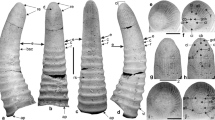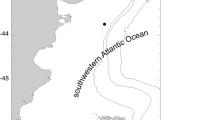Summary
Echinoids usually broadcast gametes, and do not generally engage in a high degree of parental care. However, when they do, juveniles are typically maintained among the spines, or in shallow, external depressions in the test itself. The brooding Antarctic holasteroids Urechinus mortenseni and Plexechinus nordenskjoldi are bizarre exceptions: females develop an elaborate brooding system in which a small number of direct developing young are protected. Ontogeny of post-natal brooding urechinids is marked by profound divergence in the growth trajectories of male and female apical systems. In females, this leads to dramatic departures from the patterns found in all other echinoids. Otherwise, coronal skeleton allometry of males and females is almost identical. Juveniles in brood pouches grow larger than the diameter of the apical aperture through which they must pass to reach the external environment. The apical plates, from which the brooding system is suspended, “hinge” downward to enlarge the aperture, allowing the young to emerge from the female. A possible origin for the brooding system suggests derivation by centripetal plate addition from the ocular plates in the coronal skeleton. We develop a contrasting model for the origin of the brooding system that relies on a proposed homology between genital and periproctal elements of the apical system of echinoids and the more highly developed dorsal skeleton of other echinoderm classes.
Similar content being viewed by others
References
Agassiz A (1876) On viviparous Echini from the Kerguelen Islands. Proc Am Acad Arts Sci 11:231–236
Barker M (1985) Reproduction and development in Goniocidaris umbraculum, a brooding echinoid. In: Keegan BF, O'Connor BDS (eds) Proc 5th int echinoderm conf, Balkema, Rotterdam, pp 207–214
David B, Mooi R (1990) An echinoid that “gives birth”: morphology and systematics of a new Antarctic species, Urechinus mortenseni (Echinodermata, Holasteroida). Zoomorphology 110:75–89
Emlet RB (1986) Facultative planktotrophy in the tropical echinoid Clypeaster rosaceus (Linnaeus) and a comparison with obligate planktotrophy in Clypeaster subdepressus (Gray) (Clypeasteroida: Echinoidea). J Exp Mar Biol Ecol 95:183–202
Emlet RB, McEdward LR, Strathmann RR (1987) Echinoderm larval ecology viewed from the egg. In: Jangoux M, Lawrence JM (eds) Echinoderm studies vol 2. Balkema, Rotterdam, pp 55–136
Gladfelter WB (1978) General ecology of the cassiduloid sea urchin Cassidulus caribbearum. Mar Biol 47:149–160
Kier PM (1957) Tertiary Echinoidea from British Somaliland. J Paleontol 31:839–902
Kier PM (1967) Sexual dimorphism in an Eocene echinoid. J Paleontol 41:988–993
Märkel K (1981) Experimental morphology of coronar growth in regular echinoids. Zoomorphology 97:31–52
Mespoulhé P (1992) Morphologie d'un échinide irregulier subantarctique de l'archipel des Kerguelen: ontogenèse, dimorphisme sexuel et variabilité. Thesis, Université de Bourgogne, 184 pp
Mooi R (1986) Structure and function of clypeasteroid miliary spines (Echinodermata, Echinoides). Zoomorphology 106:212–223
Mooir R (1989) Living and fossil genera of the Clypeasteroida (Echinoidea: Echinodermata): an illustrated key and annotated checklist. Smithson Contrib Zool 488:1–51
Mooi R, David B (in press) Novel skeletal topologies are related to birth in Antarctic sea urchins. C R Acad Sci Paris
Mortensen T (1909) Die Echinoiden. In: Report Deutsche Südpolar Expedition, 1901–1903. G Reimer, Berlin, pp 1–113
Mortensen T (1928) A monograph of the Echinoidea I Cidaroida. Reitzel CA, Copenhagen, 647 pp
Okazaki K, Dan K (1954) The metamorphosis of partial larvae of Peronella japonica Mortensen, a sand dollar. Biol Bull 106:83–99
Parks AL, Parr BA, Chin JE, Leaf DS, Raff RA (1988) Molecular analysis of heterochronic changes in the evolution of direct developing sea urchins. J Evol Biol 1:27–44
Philip GM, Foster RJ (1971) Marsupiate tertiary echinoids from south-eastern Australia and their zoogeographic significance. Palaontology 14:666–695
Raff RA, Field KG, Ghiselin MT, Lane DJ, Oslen GJ, Pace NR, Parks AL, Parr BA, Raff EC (1988) Molecular analysis of distant phylogenetic relationships in echinoderms. In: Paul CRS, Smith AB (eds) Echinoderm phylogeny and evolutionary biology. Clarendon, Oxford, pp 29–41
Schatt P (1985) L'édification de la face orale au cours du développement direct de Abatus cordatus, oursin incubant subantarctique. In: Keegan BF, O'Connor BDS (eds) Proc 5th int echinoderm conf. Balkema, Rotterdam, pp 339–345
Smith AB (1984) Echinoid Palaeobiology. Allen and Unwin, London, 190 pp
Wilkie IC (1984) Variable tensility in echinoderm collagenous tissues: a review. Mar Behav Physiol 11:1–34
Wilkie IC, Emson RH (1988) Mutable collagenous tissues and their significance for echinoderm, palaeontology and phylogeny. In: Paul CRC, Smith AB (eds) Echinoderm phylogeny and evolutionary biology Clarendon, Oxford, pp 311–330
Williams DHC, Anderson DT (1975) The reproductive system, embryonic development, larval development, and metamorphosis of the sea urchin Heliocidaris erythrogramma (Val.) (Echinoidea: Echinometridae). Aust J Zool 23:371–403
Author information
Authors and Affiliations
Rights and permissions
About this article
Cite this article
Mooi, R., David, B. Ontogeny and origin of the brooding system in Antarctic urechinid sea urchins (Echinodermata, Holasteroida). Zoomorphology 113, 69–78 (1993). https://doi.org/10.1007/BF00403085
Received:
Issue Date:
DOI: https://doi.org/10.1007/BF00403085




